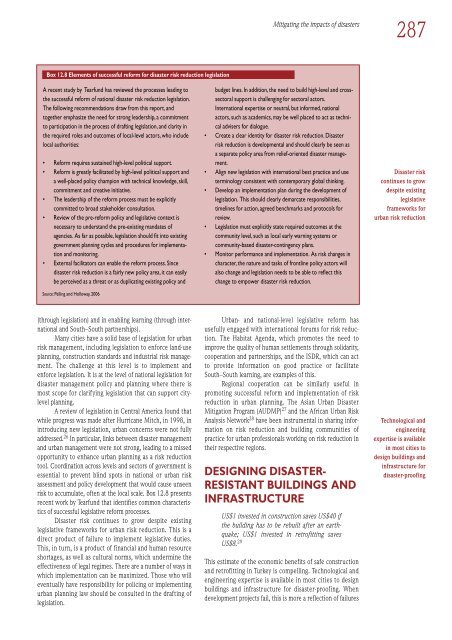Download the file - United Nations Rule of Law
Download the file - United Nations Rule of Law
Download the file - United Nations Rule of Law
- No tags were found...
You also want an ePaper? Increase the reach of your titles
YUMPU automatically turns print PDFs into web optimized ePapers that Google loves.
Mitigating <strong>the</strong> impacts <strong>of</strong> disasters287Box 12.8 Elements <strong>of</strong> successful reform for disaster risk reduction legislationA recent study by Tearfund has reviewed <strong>the</strong> processes leading to<strong>the</strong> successful reform <strong>of</strong> national disaster risk reduction legislation.The following recommendations draw from this report, andtoge<strong>the</strong>r emphasize <strong>the</strong> need for strong leadership, a commitmentto participation in <strong>the</strong> process <strong>of</strong> drafting legislation, and clarity in<strong>the</strong> required roles and outcomes <strong>of</strong> local-level actors, who includelocal authorities:• Reform requires sustained high-level political support.• Reform is greatly facilitated by high-level political support anda well-placed policy champion with technical knowledge, skill,commitment and creative initiative.• The leadership <strong>of</strong> <strong>the</strong> reform process must be explicitlycommitted to broad stakeholder consultation.• Review <strong>of</strong> <strong>the</strong> pre-reform policy and legislative context isnecessary to understand <strong>the</strong> pre-existing mandates <strong>of</strong>agencies. As far as possible, legislation should fit into existinggovernment planning cycles and procedures for implementationand monitoring.• External facilitators can enable <strong>the</strong> reform process. Sincedisaster risk reduction is a fairly new policy area, it can easilybe perceived as a threat or as duplicating existing policy andSource: Pelling and Holloway, 2006budget lines. In addition, <strong>the</strong> need to build high-level and crosssectoralsupport is challenging for sectoral actors.International expertise or neutral, but informed, nationalactors, such as academics, may be well placed to act as technicaladvisers for dialogue.• Create a clear identity for disaster risk reduction. Disasterrisk reduction is developmental and should clearly be seen asa separate policy area from relief-oriented disaster management.• Align new legislation with international best practice and useterminology consistent with contemporary global thinking.• Develop an implementation plan during <strong>the</strong> development <strong>of</strong>legislation. This should clearly demarcate responsibilities,timelines for action, agreed benchmarks and protocols forreview.• Legislation must explicitly state required outcomes at <strong>the</strong>community level, such as local early warning systems orcommunity-based disaster-contingency plans.• Monitor performance and implementation. As risk changes incharacter, <strong>the</strong> nature and tasks <strong>of</strong> frontline policy actors willalso change and legislation needs to be able to reflect thischange to empower disaster risk reduction.Disaster riskcontinues to growdespite existinglegislativeframeworks forurban risk reduction(through legislation) and in enabling learning (through internationaland South–South partnerships).Many cities have a solid base <strong>of</strong> legislation for urbanrisk management, including legislation to enforce land-useplanning, construction standards and industrial risk management.The challenge at this level is to implement andenforce legislation. It is at <strong>the</strong> level <strong>of</strong> national legislation fordisaster management policy and planning where <strong>the</strong>re ismost scope for clarifying legislation that can support citylevelplanning.A review <strong>of</strong> legislation in Central America found thatwhile progress was made after Hurricane Mitch, in 1998, inintroducing new legislation, urban concerns were not fullyaddressed. 26 In particular, links between disaster managementand urban management were not strong, leading to a missedopportunity to enhance urban planning as a risk reductiontool. Coordination across levels and sectors <strong>of</strong> government isessential to prevent blind spots in national or urban riskassessment and policy development that would cause unseenrisk to accumulate, <strong>of</strong>ten at <strong>the</strong> local scale. Box 12.8 presentsrecent work by Tearfund that identifies common characteristics<strong>of</strong> successful legislative reform processes.Disaster risk continues to grow despite existinglegislative frameworks for urban risk reduction. This is adirect product <strong>of</strong> failure to implement legislative duties.This, in turn, is a product <strong>of</strong> financial and human resourceshortages, as well as cultural norms, which undermine <strong>the</strong>effectiveness <strong>of</strong> legal regimes. There are a number <strong>of</strong> ways inwhich implementation can be maximized. Those who willeventually have responsibility for policing or implementingurban planning law should be consulted in <strong>the</strong> drafting <strong>of</strong>legislation.Urban- and national-level legislative reform hasusefully engaged with international forums for risk reduction.The Habitat Agenda, which promotes <strong>the</strong> need toimprove <strong>the</strong> quality <strong>of</strong> human settlements through solidarity,cooperation and partnerships, and <strong>the</strong> ISDR, which can actto provide information on good practice or facilitateSouth–South learning, are examples <strong>of</strong> this.Regional cooperation can be similarly useful inpromoting successful reform and implementation <strong>of</strong> riskreduction in urban planning. The Asian Urban DisasterMitigation Program (AUDMP) 27 and <strong>the</strong> African Urban RiskAnalysis Network 28 have been instrumental in sharing informationon risk reduction and building communities <strong>of</strong>practice for urban pr<strong>of</strong>essionals working on risk reduction in<strong>the</strong>ir respective regions.DESIGNING DISASTER-RESISTANT BUILDINGS ANDINFRASTRUCTUREUS$1 invested in construction saves US$40 if<strong>the</strong> building has to be rebuilt after an earthquake;US$1 invested in retr<strong>of</strong>itting savesUS$8. 29This estimate <strong>of</strong> <strong>the</strong> economic benefits <strong>of</strong> safe constructionand retr<strong>of</strong>itting in Turkey is compelling. Technological andengineering expertise is available in most cities to designbuildings and infrastructure for disaster-pro<strong>of</strong>ing. Whendevelopment projects fail, this is more a reflection <strong>of</strong> failuresTechnological andengineeringexpertise is availablein most cities todesign buildings andinfrastructure fordisaster-pro<strong>of</strong>ing
















